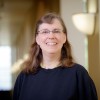This article is more than 5 years old.
This year’s meeting of the Southeast Music Library Association was held at the University of Alabama, Tuscaloosa, where we had beautiful weather and a number of interesting presentations.
Digitization Projects
We heard an update on Vanderbilt’s Global Music Archive, which has to date focused on East African music. Now they’re working on an Appalachian Dulcimer Archive (dulcimerarchive.omeka.net/), featuring “pre-revival” (pre-1940) instruments. For software, they selected Omeka (which I understand we’re investigating for our own special collections). Features of Omeka that they liked, for purposes of the dulcimer project, included its ability to handle multiple format types (visual, audio, etc.); to create new types, metadata, and tags for aspects unique to dulcimers; the plug-in for user-created data; and they plan to investigate the “Exhibits” plug-in. Also important for this project was the geographical aspect (i.e., interactive maps). They’re still troubleshooting things like the cropping of the photos of the instruments (can’t get enough in the picture), but pretty impressive results so far!
Closer to home, one of the library world’s best-kept secrets is UNCG’s cello music collection, the world’s largest, built on the personal libraries of prominent cellists, including scores with their performance annotations. In an effort to market the collection more effectively, the library is embarking on a project to digitize the collection, including images of the annotated scores, album covers, and video interviews with the donors. They’re using ContentDM for the platform, and Dublin Core for the encoding scheme, adding notes fields from the MARC records. They’ve so far done this for one donor, Bernard Greenhouse, formerly of the Beaux Arts Trio.
Copyright Instruction
One colleague related her struggle to impress the principle of intellectual property on her students. Her most successful solution: inviting one of her music faculty, a composer and performer, to speak first-hand on the needs of those who make their living writing and recording. Actually, this prof starts off with a story about his family’s vacation cabin: it happens to be adjacent to a state park, and the family has often arrived to find park visitors camping out on the premises. This usually rouses an indignant reaction from the students (“that’s so wrong!”) — making a neat segue into talking about the personal investment that goes into creating new art.
International
In an adventure somewhat analogous to Lynn’s in China, Laura Gayle Green of Florida State University was invited to help build a library collection for the music school of Mahidol University in Thailand. She brought back lots of wonderful pictures of the country, and notes on the culture. For one thing, students are often hesitant to ask questions, assuming people will think they have not been educated properly. Laura realized that her first challenge would be building the trust needed to reassure students that they can seek help without fear of being judged. Audio streaming was new to music students in this part of the world. Shoes are removed before entering homes, temples, and libraries — a reflection of the reverence in which libraries are traditionally held (and a novel way to take door counts!). The university’s goal of integrating American models of instruction with local customs is an ongoing challenge.

3 Comments on ‘Leslie at SEMLA 2012’
What an interesting conference, Leslie! Especially the shoes!
Outstanding way to impress upon students the need to respect copyright. It’s amazing how fast the perspective changes when students realize the copyright that is being infringed just might be their own one day!
I’m glad to read positive assessments of Omeka!